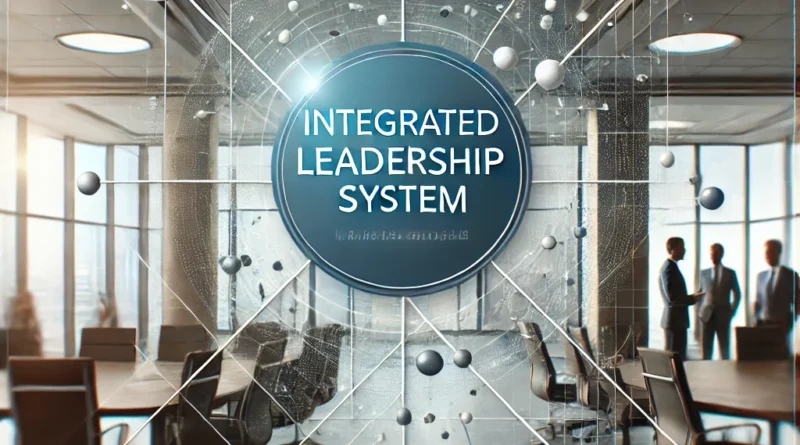Unveiling the Power of an Integrated Leadership System
But what if leadership could be improved? Can it be built into a business strategy?
This is where the integrated leadership system comes into play.
This system is a well-rounded method for leading a company. It takes advantage of leadership metrics and fuses them with leadership targets.
In this article, we will delve into the concept of integrated leadership and its components, advantages, and ways to put it into practice.
This article makes us change something as simple as the term leadership. Here we look into the ways that this partnership mechanism can enhance the effectiveness or excel in the success of a specific organization.
Introduction
What is an Integrated Leadership System?
An integrated leadership system is one that allows a leader to comprehensively approach an organization using a business defined strategy integrated into it. It is designed to set up core values where leadership is instilled through the entire organization.
The integrated leadership system is built on essential components. These include vision, alignment, and execution. It puts everyone on the same path, envisioning the same goals and turning strategies into actionable plans.
This set of components tackles the organizational and the individual approaches. Through these components, the personal strengths of a leader is aligned with the business goals so that performance can be maximized.
Communication is the heart of any system. Proper channels are needed so that the messages sent are properly received and executed. This enables people to work together and within different functions. Working together strengthens the team.
Also, the element of change has to be considered while making a leadership decision. They need to prepare for the possible changes that would entail changes in strategies. This makes the system strong since it can withstand different business settings.
Decision-making is supported by data and analytics in the system. They issue information that guides the modification of strategies. This improves as well individual skills as well as the entire organization.
Why is Leadership Important in This Era
Leadership is one of the things that need a lot of attention in the current world. This is simply because it influences the organizational culture as well as the performance of the team. A good leader can always be the source of inspiration, motivation, direction, and success of the team.
There is fiercer competition than ever before, because of globalization. Businesses have to deal with issues that need flexible leadership. A leader is required to operate within a highly complex and dynamic environment, while remaining focused on the strategic objectives.
The ways of the world have changed and with it the requirements of leadership. There is the presence of technology which requires every leader to be an innovator and very handy. This change calls for a new and effective leadership system that employs modern tools and techniques.
In the contemporary world, ethical business conduct has received more attention. It is critical to provide trust and credibility through transparency and accountability. An integrated leadership system cultivates these values within the organization.
At the same time, a leader plays a role in engagement and attrition rates as well. Effective leaders strengthen work relations, and people want to work and stay with the company, which guarantees the sustainability and success of the organization in the long run.
At the end of the day, leadership is not just about profit anymore. It is about transforming the world, tackling social issues, and advocating for businesses to care. Successful implementation of Integrated Leadership equips an organization to tackle all these complexities.
Core Components of an Integrated Leadership System
Essential Leadership Traits
The foundations of an integrated leadership system are rooted in specific traits. These characteristics serve as a basis in providing the needed leadership in the organization. The ability to think ahead and formulate plans stands out which helps a leader visualize and define goals in the future.
Empathy makes a leader closer to the people in her or his team. It creates an enabling environment for motivation. Trust is fundamental and with understanding, a team can be motivated. An empathetic leadership style creates a climate that is supportive and conducive to teamwork and creativity.
In an Integrated System, the ability to make decisions is important. Informed decisions have to be made instantly. There is a need to evaluate whether the decision outweighs the opportunity. He or she must be able to carry the teams very well. Good decision-makers depend on several factors, such as logical and scientific reasons.
Clear-cut communication helps bridge any gaps between leaders and their teams. If leaders can communicate in a clear and precise manner everything gets better. This helps reduce misunderstandings and fits helps work efforts to target common goals.
Helpfulness ensures that the leaders can adjust accordingly in perpetual shifts in the leadership structure. This trait helps them manage change and still be effective when things do not know what to expect. It is important in business to understand that the world is always changing.
Having grit as an ethical principle is a prerequisite in leadership. Integrity in leaders helps gain respect and build credibility, fostering an ethical workplace culture. This trait ensures actions are taken in line with the ‘words’ of the organization, thus ensuring trust.
Finally, being able to overcome difficult situations is what helps leaders overcome the obstacles in front of them. This sets a person able to face challenges with a determination to never give up, which is important when things get tough. Resilient leaders are those who motivate their subordinates to push past hindrances and be successful.
When leaders work on these traits, the impact is felt on a wider scale. They encourage growth, collaboration, and innovation in the organization. This integration improves outcomes and fuels the success of the leadership system.
Leadership Development Framework
It is crucial to design an appropriate framework for leadership development. The framework is useful for fostering effective leaders in the integrated leadership system. It begins with understanding their leadership skills. Proper understanding reveals the strengths and weaknesses of an individual and thus helps shape development strategies.
Targeted learning experiences through structured training programs enhance junior leaders’ skills and abilities. These learning initiatives can be in the form of workshops, seminars, and many others, providing the leaders with the much-needed skills and knowledge.
Another crucial part of leadership development is mentorship. Mentors help young and budding leaders by guiding them with valuable insights and advice from their vast experiences. This helps young leaders to grow and gain confidence in their abilities.
Loops of feedback can also be very beneficial for the senior staff members within this framework. Regular feedback lets the leaders know if they are effective in refining their approaches and strategies. Feedback of this nature often leads to, and indeed encourages, further improvements of all kinds.
Technology also plays an important role in leadership development. With the help of e-learning and other digital means, learning can be done easier and more flexible. Leaders are therefore able to obtain information and attend the much needed training when he is free, greatly improving his development.
Leaders’ cross-functional rotation reinforces leadership development. These moving and changing of leaders from one position to another and from one department to another broaden their horizons. It improves their understanding of how the entire organization works and how different departments work together.
In summary, the proactive alignment of leadership development with the organization’s strategy is very important. Development programs should parallel the strategic intent of the organization. This makes it possible for the leaders to add value to the organization and facilitate the achievement of the organization’s mission.
In short, systems of comprehensive measures for leadership development are fundamental. It enables leaders to develop the necessary competencies and provide the attention it requires to support the goals of the organization. This system, in turn, improves the effectiveness of the leadership system and its sustainability.
Set Leadership Goals
Strategic Goal Setting
Strategic goal setting should be the core pillar of effective leadership. It gives a sense of direction and intent which helps to position the teams to the wider organizational strategy. As a significant part of this process, having a vision is very important, as it assists them in formulating what they want to achieve in the long run.
In the first place, there is a need for the leaders to establish areas that will safeguard the success of the business. Because of the organizational purpose and the ecosystem, it is possible to set the necessary goals. These should be specific, measurable, achievable, relevant, and time-bound. In other words, they need to be SMART.
This brings us to the second principle – engaging the members of the team in the goal-setting process is critical. It boosts ownership and responsibility, ensuring that it is everyone’s concern to deliver on the targets. It is possible through conversations to have insights and ideas that lead to deeper and better goals.
Regular reviews are a basic requirement in strategic goal management. Reviews enable leaders to track progress, revise goals, and appreciate the great leaps made. This cyclical process guarantees that no matter the time, goals continue to be achievable and relevant.
Successful goal setting is a blend of ambition and realism. Leaders should pursue attainable goals that challenge. This balance helps in increasing motivation and increases the chances of setting a culture of change and improvement.
Practical strategic goal setting helps in being adaptable to the process. It involves dealing with clear priorities to set up active engagement and adjust to specific changes. Understanding this process helps leaders focus their activities toward the strategic direction of the organization to ensure success in the long term.
Aligning Personal and Organizational Objectives
Aligning one’s self-objectives with those of the company is an aspect of great importance for leaders. This helps to ensure that everyone’s activities contribute towards the company’s goals. It promotes a sense of Jamaicanness and purpose within the team.
This process starts from within. Great leaders need to understand what motivates them and what they want out of their careers. This clarity helps them align their actions with the needs of the organization. With personal honest assessment, leaders will be able to find where personal goals and organizational goals meet.
Open communication is critical. Leaders need to talk with their managers regarding their personal goals and how they can marry them with the team and organizational objectives. Such conversations foster appreciation and understanding from both friends.
The creation of a development plan cuts across all the possible aspects covered for integration to work. This plan should describe how personal goals are beneficial to the organization. In essence, the development plan serves as a framework for active participation within the team.
Achieving alignment of objectives should also consider leveraging an individual’s strengths. So long as leaders are working in their areas of strength, they can derive personal satisfaction while increasing company performance, which improves engagement and enthusiasm in their roles.
Lastly, maintaining alignment can be achieved through periodic check-ins. These are opportunities to evaluate if goals are being met, to monitor progress, and to make modifications to the goals as necessary. They guarantee that the personal ambitions still support the overarching strategic plans of the organization.
It can be concluded that the marriage of personal and organizational objectives cultivates a balanced and efficient place of work. It guarantees the efforts made by the leaders are not just fulfilling to them, but are also instrumental towards the success of the corporation.
Identifying and Leveraging Leadership Strengths
Personal Evaluation Data
Knowing and understanding the specific strengths of a person is among the basic aspects of leadership. Self-assessment tools always come in handy in this stage of self-discovery. These tools reveal information about the personal attributes, competencies, and even the gaps that exist.
The StrengthsFinder assessment is one of the most common tools. This assessment finds the individuals’ main strengths and puts them in categories called themes based on how they tend to think, feel, or act. It helps leaders know what they do best.
Another useful tool is the Myers-Briggs Type Indicator (MBTI). This tool measures the specific personality of the individual and details his or her guiding principles regarding communication and decision-making. These traits let a leader adapt to several situations.
The 360-degree feedback method is also useful. It collects feedback from the individual’s colleagues, subordinates, and even supervisors to present an overall picture of their leadership skills. This feedback gives a different perspective on the individual’s strength and sheds light on skills that may have remained dormant for a long time.
These self-assessment tools do more than just provide data; they stimulate personal and professional growth. Leaders understand the tendencies that they naturally have, and that need to be worked on when they analyze the outcomes. This is the first step to enhancing the strengths that the leader has in the context of his or her team.
All in all, these tools enable leaders to focus on their strengths. Leaders are able to rise up to challenges and promote a healthy working atmosphere, having a strong understanding of oneself.
Focusing on Existing Strengths for Growth
Once strengths have been established, the following step is to enhance them. This enables leaders to contribute more profoundly to their organizations. It also improves leadership effectiveness and enhances team performance.
You should strive to do things you are good at instead of focusing on what you are weak at. Leaders who engage in competent tasks are more likely to succeed. This strategy enhances personal and professional engagement.
To develop further, strengths must be augmented with constant development. Leaders need to target workshops, mentorships, or certain courses aimed at developing their particular skills. Furthermore, keeping abreast of trends and developments in the sector improve their skills.
Leaders also need to stop doing what they are not proficient at. This allows them to focus on what they are good at, which will increase their performance. This delegation encourages trust and collaboration among team members.
Networking can also serve to build newer perspectives on existing skills. Peers and other industry professionals can provide valuable insights that can lead to strong creative leadership.
Progress and achievements must always be recognized through regular self-reflection. How far one has progressed is an excellent motivation for one’s efforts. It aids in the construction of a strong self-image and in the identification of even more gaps that need to be filled.
Strengths need to be constantly built upon, leaders need to increase their impact and make the world a better place. By doing so these leaders will not only change themselves but greatly impact their organisations for the better.
Advantages of Integrated Leadership System
Increased Team Effectiveness
An integrated leadership system forms thes backbone to the improvement of the team’s effectiveness. It makes it possible for team objectives to be integrated with corporate goals which promotes unity and coherence. Owing to this focus on unity, all purposes for the actions are defined and directed.
Leadership-integrated systems build trust. Their understanding of their roles leads to greater expectancy of accountability, and consequently, productivity increases. This level of trust enables the team to reach their peak performance.
An integrated system also enables cooperation between various units. Innovation and functional silos are overcome by the integrated system. Better problem-solving and decisions are made with the use of different angles and perspectives.
Another important element is the ability to adjust. Teams will have the ability to adapt quickly to the changing conditions of the market. Adaptability ensures the competitiveness and effectiveness of teams during trying times.
In the end, an effective leadership system encourages a culture of improvement in the organization. It creates feedback loops through which the learning and growth of the teams can take place. This focus on development leads to high performance and achievement over the long term.
Sustainable Organizational Growth
Sustainable growth is one of the benefits of an integrated leadership system. This has been done by setting of leadership objectives that are consistent with overarching strategies, which provides a basis for effective achievement in the future.
One standout component is strategic vision. Integrated systems have well-articulated and focused goals for the business. Leaders provide direction for their organizations in a manner that creates forward motion and allows for growth over time.
These systems make it easier to efficiently allocate resources. Streamlining objectives and processes leads to better allocation of resources. This efficiency leads to innovation and flexibility, which is of great importance in today’s changing market.
In addition, integrated leadership systems foster resilience. By embedding robust communication channels, they prepare the organization for turbulence. Leaders are ready to deal with interruptions and still make sure that progress happens.
Employee engagement is key for growth. Engaged employees enhance productivity and are more committed to the organization. Integrated systems allow the environment to be such that engagement flourishes, which is advantageous in the long run.
In any case, an integrated leadership system facilitates a culture of sustainability. It motivates people by matching their individual goals with the goals of the organization. This motivates them to perform as well as the organizational growth is reasonable and maintained over some time.
Conclusion
Future of Leadership Development
The very nature of leadership development seems to be on the edge of change, with integrated leadership systems driving it. As organizations grapple with different challenges, such systems provide a unified approach to exploit the benefits of leadership and accomplish the objectives. When leaders commit to continuous improvement and flexibility, their teams are more inclined to foster creativity and adaptability. New tools powered by AI and data technology will make it easier to supervise; this will help ensure leadership goals are met in precise alignment with business goals. Integrated leadership systems will be pivotal in nurturing leaders who can grow and change the organization sustainably.




